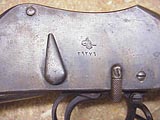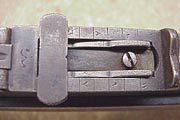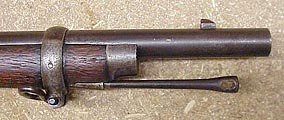
|
|
Russo-Turkish War of Liberation 1877-1878 Chapter Three - Small arms of the warring states - Ottoman empire "Henry-Martini" model 1871 The most frequently used fire arms in the Turkish army were British rifles produced in the United States, Henry-Martini system model 1871. It was an improved version of the Peabody rifle model 1862, constructed by the Boston engineer Henry Peabody. The original bolt of the rifle is placed in a steel case with the barrel wound up on the one side and a butt-stock attached to the other side with the help of a long screw. When pressing the lever placed behind the trigger clutch, the front part of the bolt falls baring open the outlet of the cartridge chamber. The extraction1 of the cartridge case was done with the help of a special extractor, which was set in motion by the falling breech bolt. The mechanism created by Henry Peabody was reliable due to its simple construction. It ensured the good tightness2 of the bolt despite the abundant residue, which was produced when the black gunpowder burned. The Henry Martini rifle was created by the Swiss constructor Frederico Martin I and by the English arms specialist Alexander Henry. It was shown for the first time in England in 1873 during competitions. The joint design by the two constructors was named “Peabody-Martini”. Manufacturers stamped this name on the left side of the bolt case. Later, a number of them started to remove the name of H. Peabody. That is the reason why it has been referred to as “rifle system Martini” or “rifle system Martini-Henry”. In any case, we are talking about the same system, which has become popular as “rifle system Henry-Martini”. It should be noted that the constructor A. Henry had designed the barrel and its grooves. The seven small grooves had the form of the Greek letter omega, which prevented the sticking of a big quantity of gunpowder residue on them and facilitated their cleaning. Unable to provide its army with up-to-date weapons, the Turkish army ordered 650,000 rifles Henry-Martini from the United States.3 On the eve of the war, about 70 percent of the infantry units were armed with this weapon. When comparing the tactical and technical qualities of the rifles Chassepot and Henry-Martini, we can come to the conclusion that Bulgarian volunteers were in an unequal position with relation to Turkish soldiers. The difference is most striking when comparing the ammunitions used with the two rifles. The paper cartridges of the Chassepot rifle were vulnerable to moisture and mechanical interactions. At the same time, outside conditions had practically no influence on the unitary metal cartridges of the Henry-Martini rifle. The use of more up-to-date ammunitions had created conditions to simplify the bolt of the American rifle. The rubber rims, which were used in the Chassepot rifles, became superfluous as the air-tightness of Henry Martini was achieved by the metal cartridge case. The long needle igniting the fuse was replaced by a shorter and thicker one. As a result, the bolt constructed by Henry Peabody worked in a way that was simpler and more reliable. The firing distance of the two rifles was different as well. According to information provided by the arms specialist Rainhold Gunter, the Henry Martini rifles had the maximum firing distance of 1,600 meters, while the Chassepot rifle had 1,300 meters. In his letters written during the Russian-Turkish War, Sergei Petrovich Botkin had also evaluated highly the American rifles. He wrote: “Obviously the enemy is strong, clever and cunning, seems to be well armed: the Martini weapons fire at 1,800 feet”. The Chassepot rifles fell slightly behind when comparing the firing speed. A well-trained shooter could produce 10 shots per minute with the Chassepot rifle, while with the Henry-Martini – 12 shots per minute. Difficulties, which arose when charging in “lying” position, were viewed as a significant flaw of the American rifle. The reason for that was the lever, placed behind the trigger clutch, which had to be pushed downwards to the utmost in order to have the outlet of the cartridge chamber opened. The high initial speed of the bullet caused comparatively higher recoil of the rifle, which could harm the shooter's shoulders. Nonetheless, Russian soldiers and Bulgarian volunteers preferred to use the trophy rifles.
|
Mannlicher ©2003-2004. All rights reserved. No part of this site can be reproduced in any way without the explicit permission of the authors.





